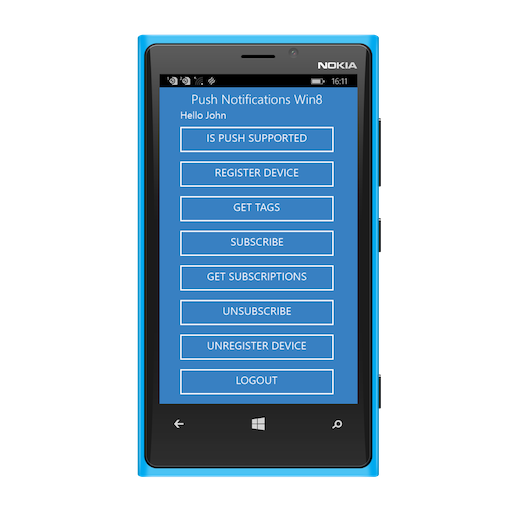在 Windows 8.1 Universal 和 Windows 10 UWP 中处理推送通知
improve this page | report issue
概述
可以使用 MobileFirst 提供的通知 API 来注册和注销设备以及预订和取消预订标记。 在本教程中,您将学会如何在使用 C# 的本机 Windows 8.1 Universal 和 Windows 10 UWP 应用程序中处理推送通知。
先决条件:
- 确保您已阅读过下列教程:
- 本地运行的 MobileFirst Server 或远程运行的 MobileFirst Server。
- 安装在开发人员工作站上的 MobileFirst CLI
跳转至:
通知配置
创建新的 Visual Studio 项目或使用现有项目。
如果该项目中还没有 MobileFirst 本机 Windows SDK,请遵循将 MobileFirst SDK 添加到 Windows 应用程序教程中的指示信息。
添加推送 SDK
- 选择“工具 → NuGet Package Manager → Package Manager Console”。
- 选择要安装 MobileFirst 推送组件的项目。
- 运行 Install-Package IBM.MobileFirstPlatformFoundationPush 命令来添加 MobileFirst 推送 SDK。
必备的 WNS 配置
- 确保应用程序具备 Toast 通知功能。 可在 Package.appxmanifest 中启用此功能。
- 确保使用向 WNS 注册的值来更新
Package Identity Name和Publisher。 - (可选)删除 TemporaryKey.pfx 文件。
通知 API
MFPPush 实例
必须在一个 MFPPush 实例上发出所有 API 调用。 为此,需要创建一个变量(例如,private MFPPush PushClient = MFPPush.GetInstance();),然后在该类中调用 PushClient.methodName()。
也可以针对要访问推送 API 方法的每个实例都调用 MFPPush.GetInstance().methodName()。
验证问题处理程序
如果 push.mobileclient 作用域映射到安全性检查,那么需要确保在使用任何推送 API 之前,存在已注册的匹配验证问题处理程序。
在凭证验证教程中了解有关验证问题处理程序的更多信息。
客户端
| C Sharp 方法 | 描述 |
|---|---|
Initialize() |
针对提供的上下文,初始化 MFPPush。 |
IsPushSupported() |
设备是否支持推送通知。 |
RegisterDevice(JObject options) |
向推送通知服务注册设备。 |
GetTags() |
在推送通知服务实例中检索可用的标记。 |
Subscribe(String[] Tags) |
使设备预订指定的标记。 |
GetSubscriptions() |
检索设备当前预订的所有标记。 |
Unsubscribe(String[] Tags) |
取消对特定标记的预订。 |
UnregisterDevice() |
从推送通知服务注销设备。 |
初始化
客户机应用程序连接到 MFPPush 服务时,需要执行初始化。
- 应先调用
Initialize方法,然后再使用任何其他 MFPPush API。 - 它会注册回调函数以处理已收到的推送通知。
MFPPush.GetInstance().Initialize();
是否支持推送
检查设备是否支持推送通知。
Boolean isSupported = MFPPush.GetInstance().IsPushSupported();
if (isSupported ) {
// Push is supported
} else {
// Push is not supported
}
注册设备并发送设备标记
向推送通知服务注册设备。
JObject Options = new JObject();
MFPPushMessageResponse Response = await MFPPush.GetInstance().RegisterDevice(Options);
if (Response.Success == true)
{
// Successfully registered
} else {
// Registration failed with error
}
获取标记
从推送通知服务检索所有可用标记。
MFPPushMessageResponse Response = await MFPPush.GetInstance().GetTags();
if (Response.Success == true)
{
Message = new MessageDialog("Avalibale Tags: " + Response.ResponseJSON["tagNames"]);
} else{
Message = new MessageDialog("Failed to get Tags list");
}
预订
预订所需的标记。
string[] Tags = ["Tag1" , "Tag2"];
// Get subscription tag
MFPPushMessageResponse Response = await MFPPush.GetInstance().Subscribe(Tags);
if (Response.Success == true)
{
//successfully subscribed to push tag
}
else
{
//failed to subscribe to push tags
}
获取预订
检索设备当前预订的标记。
MFPPushMessageResponse Response = await MFPPush.GetInstance().GetSubscriptions();
if (Response.Success == true)
{
Message = new MessageDialog("Avalibale Tags: " + Response.ResponseJSON["tagNames"]);
}
else
{
Message = new MessageDialog("Failed to get subcription list...");
}
取消预订
取消对标记的预订。
string[] Tags = ["Tag1" , "Tag2"];
// unsubscribe tag
MFPPushMessageResponse Response = await MFPPush.GetInstance().Unsubscribe(Tags);
if (Response.Success == true)
{
//succes
}
else
{
//failed to subscribe to tags
}
注销
从推送通知服务实例注销设备。
MFPPushMessageResponse Response = await MFPPush.GetInstance().UnregisterDevice();
if (Response.Success == true)
{
// Successfully registered
} else {
// Registration failed with error
}
处理推送通知
要处理推送通知,需要设置 MFPPushNotificationListener。 可实现以下方法来执行此操作。
-
使用 MFPPushNotificationListener 类型的接口创建类
internal class NotificationListner : MFPPushNotificationListener { public async void onReceive(String properties, String payload) { // Handle push notification here } } - 通过调用
MFPPush.GetInstance().listen(new NotificationListner())将该类设置为侦听器 - 在 onReceive 方法中,您将收到推送通知,并可以处理关于期望行为的通知。

Windows Universal 推送通知服务
无需在服务器配置中打开特定端口。
WNS 使用普通的 http 或 https 请求。
样本应用程序
单击以下载 Windows 8.1 Universal 项目。
单击以下载 Windows10 UWP 项目。
用法样例
请查看样本的 README.md 文件以获取指示信息。
▲Inclusive terminology note: The Mobile First Platform team is making changes to support the IBM® initiative to replace racially biased and other discriminatory language in our code and content with more inclusive language. While IBM values the use of inclusive language, terms that are outside of IBM's direct influence are sometimes required for the sake of maintaining user understanding. As other industry leaders join IBM in embracing the use of inclusive language, IBM will continue to update the documentation to reflect those changes.